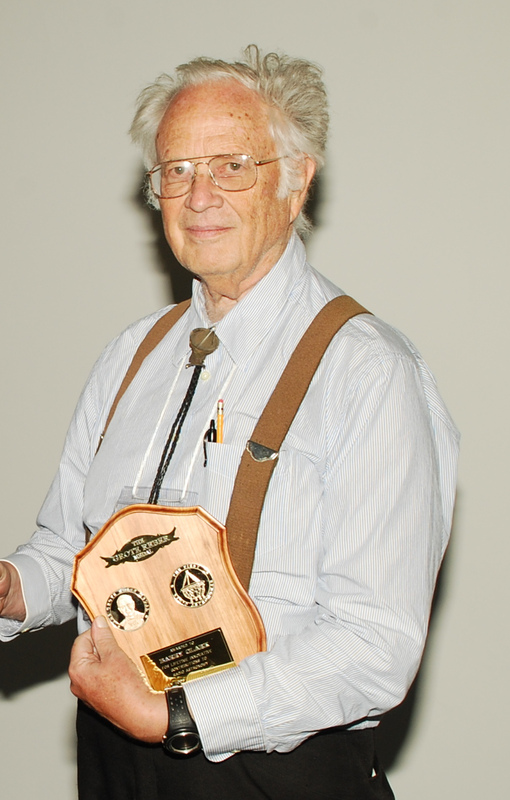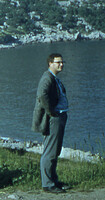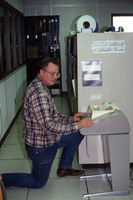Finding Aid to the Papers of Barry G. Clark, 1957-2020
   |
|
See also the Papers of Woodruff T. Sullivan III, which include a 45 minute interview with Clark conducted in 1978. Contents:
Location of collection: National Radio Astronomy Observatory, Archives, 520 Edgemont Rd., Charlottesville, VA. Phone: 1-434-296-0203, email: archivist at nrao.edu. Title and dates of the collection: Papers of Barry G. Clark, 1957-2020 Size of the collection: 5.25 linear feet Papers/Records created by: Clark, Barry G. (1938- ) Short description of collection: The collection includes materials related to Clark's work on the Green Bank Interferometer, on VLBI and early VLBI experiments, and on the VLA and the EVLA.
Biography: Barry Clark is a Senior Scientist Emeritus at the NRAO and was a member of the NRAO scientific staff from 1964 until he retired at the end of 2004. Clark received his BS and PhD degrees in astronomy from Caltech 1959 and 1964 respectively. His scientific career has extended over more than half a century, starting with his research on the solar corona and the Galactic magnetic field while still an undergraduate student at Caltech. As a graduate student, Clark used the Caltech radio interferometer to study Galactic atomic hydrogen clouds, and suggested that interstellar hydrogen is found in two distinct temperature phases - thus leading to our current understanding of the multiple phases of the interstellar medium. With Arkady Kuz'min he showed that the radio radiation from Venus came from the solid surface. Later, he led some of the earliest VLBI studies of quasars demonstrating their extraordinarily small dimensions. At NRAO, Clark worked on the upgrade of the Green Bank Interferometer from two elements to three, especially on making it a very early example of a computer-controlled radio astronomy instrument. He led the development of the world's first digital recording, software correlator for the Very Long Baseline Interferometer (VLBI) system and the subsequent enhancements to its sensitivity. He is probably best known, however, as the intellectual force behind the Very Large Array (VLA). Later, he participated in the design of the Very Long Baseline Array (VLBA) and in the upgrade of the VLA to its current state. For several decades, he led the process of evaluating and scheduling proposals for using the VLA and VLBA.Clark is a member of the American Astronical Society and International Astronomical Union, and a fellow of the American Association for the Advancement of Science. For his many pioneering developments in radio interferometry and synthesis imaging, Clark received the 2009 Grote Reber Gold Medal. In 1991, he was awarded the George Van Biesbroeck Prize for his long-term extraordinary unselfish service to astronomy. [Biographical note written by Kenneth I. Kellermann with additions by Barry Clark.] Accession history: Materials were donated by Clark to the NRAO/AUI Archives in 2023. Access to collection: No restrictions. The Archives are open part-time; contact the Archivist for appointment. Restrictions on use of collection: None. Publication rights: Copyright has been assigned to the NRAO/AUI Archives. All requests for permission to publish or quote from manuscripts must be submitted in writing to the Archivist. Preferred citation: National Radio Astronomy Observatory/Associated Universities, Inc. Archives, Papers of Barry G. Clark, <series/unit/subunit/box #>. After the initial citation, abbreviations may be used: NRAO/AUI Archives, Clark Papers, <series/unit/subunit/box #>. Processing notes: Arrangement, description, indexing, foldering and boxing of the material was done by Ellen Bouton in 2023. VLA/VLBA observing schedules and New Mexico weekly coordination meeting records collected by Clark were incorporated into the Records of NRAO. During the processing, fasteners were removed, and materials were removed from binders of various types. Duplicates were discarded. Recollections and CV Series: Includes a memoir written for family about Clark's personal and professional life (ca. 2022), program for the 1998 meeting "Radio Interferometry: The Saga and the Science" (honoring Bary Clark at 60), and Clark's curriculum vitae written in 2003/2004. Size: 1 folder. Diary Notebooks Series: Two spiral-bound notebooks for 11 July 1975-26 May 1978, primarily covering early VLA days but including other topics and events. Size: 2 notebooks (1 folder) Clark Publications Series: Publications and reports on which Clark is an author, 1958-1994. Note: This is a set of publications retained by Clark, and is not a complete set of his publications. Size: 1 folder. Green Bank Interferometer Series: This series includes reports and memos dated 1964-1974 related to the Green Bank Interferometer, on making the GBI a very early example of a computer-controlled radio astronomy instrument, the upgrade from two elements to three, and the addition of the 45 foot to add a fourth element. Size: 0.5 linear feet. Click here for an item listing. Related materials: See also the Green Bank Interferometer Unit in the Records of the NRAO,. Very Long Baseline Interferometry (VLBI) Series: This series includes correspondence, memos, charts, proposals, reports, and notes dated 1965-1975 related to Clark's interferometry work. Clark led the development of the world's first digital recording software correlator for the Very Long Baseline Interferometer (VLBI) system and the subsequent enhancements to its sensitivity. Size: 0.5 linear feet. Click here for a folder listing of materials on interferometers and interferometry. Related materials: see the Records of the NRAO, the Papers of Donald C. Backer, the Papers of Marshall H. Cohen and the Papers of Kenneth I. Kellermann.
Very Large Array (VLA) Series: Clark participated in discussions of and planning for the VLA from its beginning in the early 1960s, and was among the earliest NRAO staff to move to New Mexico, continuing his involvement with and contributions to the VLA throughout his career. This series includes materials dated 1965-1987 on planning and development for the VLA, focusing primarily or computers and data processing. Size: 1.75 linear feet for all VLA materials. Click here for a folder listing. Specialized units are listed below. Related materials: See also VLA materials in the Records of NRAO.
Expanded Very Large Array (EVLA) Series: Materials dated 2001-2009 related to the upgrade/expansion of the Very Large Array (VLA), a project begun in 2001, and completed in 2012. Size: 0.5 linear feet. Click here for a folder listing. Related material: See EVLA materials in the Records of NRAO, in the Papers of Robert L. Dickman and the Papers of Raymond P. Escoffier; the numbered EVLA memo series, including memos on the WIDAR Correlator, have been digitized by the NRAO Library. Miscellany Series: Includes miscellaneous notes and correspondence, articles on Owens Valley Radio Observatory, Hemenway thesis materials, photos and memorabilia. Material is dated 1957-1999. Size: 0.5 linear feet. Click here for a folder listing. |
